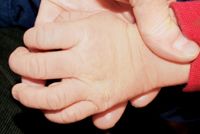20-month old boy has had extremely dry skin since birth
A mother seeks an evaluation of her 20-month-old son, who has grown slowly and has had leathery dry skin since birth. He also has had multiple skin infections and chronic conjunctivitis, and he has delayed language development.

Key Points
The Case
A mother seeks your help in evaluating her 20-month-old son, who has grown slowly and has had leathery dry skin since birth. He also has had multiple skin infections and chronic conjunctivitis, and he has failed 3 hearing tests and has delayed language development.
Diagnosis:
CLINICAL FINDINGS

These children typically have erythrodermic skin at birth, with diffuse mild red scaly patches on the skin that peel within the first few weeks of life. During their first year, most patients develop the characteristic atypical ichthyosis with fine stippled papules, which gives the skin (most commonly on the scalp, face, and extremities) a leathery texture. Other findings include a distinctive keratoderma of the palms and soles with a granular texture, as well as fixed thick scaly plaques, found most commonly on the cheeks, forehead, and ears but occasionally generalized. Variable alopecia resulting from follicular keratosis may be present early in life. Biopsy of the skin shows nonspecific hyperkeratosis with parakeratosis and acanthosis.3,4
In half of patients with KID syndrome, nails may be hypoplastic or dysplastic, and teeth may be hypoplastic and prone to caries.3 Recurrent mucocutaneous fungal and bacterial infections are common; these infections may cause sepsis and death in the neonatal period.
Although most children with this syndrome have normal intellect, development may be delayed because of hearing loss.3,4 Moreover, infants and young children with KID syndrome may gain weight and grow slowly for unknown reasons, possibly because of increased metabolic needs resulting from the erythroderma and/or recurrent infections. Severe or total nonprogressive neurosensory deafness typically presents at birth.4

Squamous cell carcinoma in the skin and tongue, particularly in the hyperkeratotic plaques, has been reported in 11% of patients.6
ETIOLOGY
Although the majority of reported cases have been sporadic, a third of cases have been familial, and an autosomal dominant pattern has been recognized.7 In recent years, many of the cases have been linked to a heterozygous missense mutation in connexin-26 gene (found on chromosome 13) called GJB2.8 Connexin-26 protein is a component of gap junctions in epithelial cells that permit the passage of small molecules. Connexin-26 also plays a critical role in the recycling of potassium in the inner ear; its dysfunction is hypothesized to cause the neurosensory deafness in patients with KID syndrome.
DIFFERENTIAL DIAGNOSIS
Although KID syndrome is a rare disorder, only a little detective work was required to make the diagnosis. A search of the Online Mendelian Inheritance in Man database for disorders with ichthyosis and deafness as symptoms turned up a number of related disorders characterized by gap junction mutations. The first disorder produced by the search, ichthyosiform erythroderma, cornea involvement, and deafness, is associated with hepatic cirrhosis, KID syndrome is listed second, and the third disorder, called gap junction protein beta-2 (GJB2), has the same mutation as KID syndrome.
The skin findings in KID syndrome may also overlap with the findings in other forms of hereditary ichthyosis, such as ichthyosis vulgaris or X-linked ichthyosis. Epidermolytic hyperkeratosis is rare congenital ichthyosis that presents at birth with bullae formation and later with keratoderma of the palms and soles and dramatic thickening of the skin, particularly on the flexural creases of the extremities. Sjogren-Larsson syndrome (ichthyosis with mental retardation and spastic diplegia or quadriplegia), ichthyosis hystrix (also presents with deafness and ichthyosis with epidermal nevi), and IFAP (ichthyosis follicularis, alopecia, and photophobia) can also be considered as part of the differential diagnosis.
Recognize & Refer: Hemangiomas in pediatrics
July 17th 2019Contemporary Pediatrics sits down exclusively with Sheila Fallon Friedlander, MD, a professor dermatology and pediatrics, to discuss the one key condition for which she believes community pediatricians should be especially aware-hemangiomas.